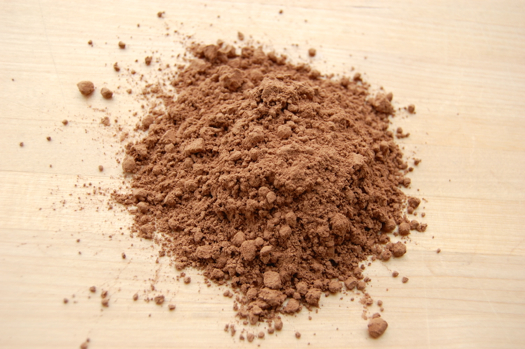Cocoa Powder

When chocolate liquor, the paste you get when you grind roasted cacao nibs, is placed in a hydraulic press and squeezed, two products result: cocoa butter and cocoa powder. However it’s important to note that the process doesn’t entirely separate the two. Some cocoa butter remains in the cocoa powder, which is designated as either low, medium or high fat, the fattiest being 24% cocoa butter and the leanest being 10% cocoa butter. The rest is all cocoa solids.
It’s fair to think of cocoa powders as one might think of coffees. There are blended powders and single origin “varietal” powders, light roast and dark roast, high quality and low quality. As I mentioned in the chocolate primer, there are three major cultivars of cacao: criollo, forester and trinitario. Criollo is the rarest and most expensive, as it’s considered by many chocolate connoisseurs to be the best, which is to say both mellower and more fragrant. I have no opinion on that since I’ve never tried these cocoa powders back-to-back. You might. If so let me know your thoughts.
Cocoa powders come in two basic varieties: “Dutched” and “un-Dutched”. The difference is that Dutched is mellower than un-Dutched as it’s had an alkaline — usually potassium carbonate — added to it to neutralize it. Cacao beans are naturally acidic but become even more so when they’re fermented, just like fermented dairy products and sourdough bread. That acidity gives cocoa powder a sharpness that chocolate consumers have — at least historically — disliked, hence the Dutching. These days harsh chocolates, like harsh coffees, are fashionable and as a result Dutched cocoa is harder to find (though Droste is an example of a Dutched cocoa that many grocers still carry).
Why is un-Dutched chocolate so popular? In large part it’s the aesthetic, a lot of people just like the more pronounced taste. Some people regard potassium carbonate as an unhealthy “additive”, though the compound is common in water softener salts, in baking powders and is frequently used to balance the pH of wine. Others believe that the Dutching process renders chocolate less healthy since potassium carbonate degrades flavanols, the antioxidants chocolate has become famous for since the 90’s. And while there’s no question that Dutching destroys flavanols, those who extol the health benefits of chocolate are on shakier scientific ground every year, as recent studies have shown that antioxidants have no quantifiable benefits and may even be bad for you. Which is probably why Dutched chocolate has been making something of a comeback in recent years.
The swing of the pH pendulum has had some consequences for bakers as pH can be important in batters, especially those leavened with primarily with baking soda. Indeed many recipes written since the 90’s rely at least in part on the acidity of un-Dutched cocoa powder to initiate a leavening reaction. My advice: read your ingredient lists carefully to see if the writer specifies one or the other. A little extra acidity is rarely a problem in, say, a muffin batter. Too little, however, can have adverse consequences: compromised volume and soapy flavors which result when soda reacts with fat.
Nice summary Joe. I’ve also recently read a couple good articles/blogs on the differences between natural and dutched powders:
King Arthur Flour
Serious Eats
The main takeaway is for at least American origin recipes or ones with only baking soda as the leavener, you’re probably best off with natural. If it has baking powder, you can pretty much swap them out.
Both of the articles had some good examples of the same recipe baked with the different powders.
Hi Gerik!
And yes that’s quite true. If the recipe is soda-only or calls for soda in addition to baking powder you know that the recipe writer was relying on other acid ingredients in the mix to create the leavening reaction. And while natural cocoa powder doesn’t pack the acid punch of say, buttermilk, it almost certainly will count in the finished product. If the recipe has only baking powder in it you can pretty much use what you like. It’s rare that extra acid harms anything in a batter, and is more often than not a help as it helps inclusions like chocolate chips and berries stay suspended.
Thanks for the comment and the excellent links!
– Joe